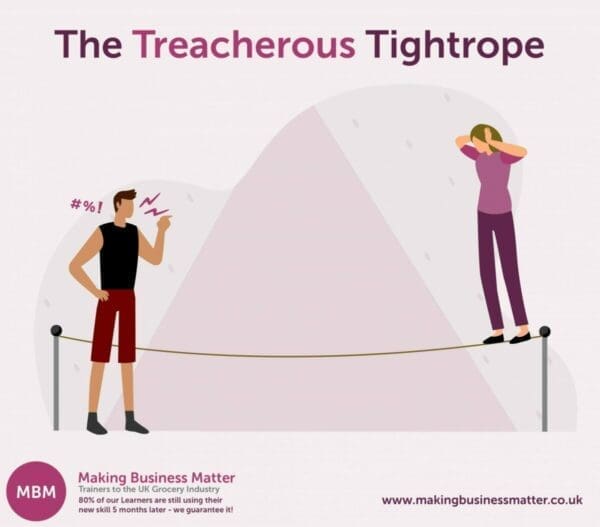Ever Found That You Are Beating Yourself Up But Cannot Actually Fathom What You Did Wrong?
You might have been subjected to the passive-aggressive indecisive tormentor and made to walk the treacherous tightrope.
Over the last 20 years of being a student of soft skills, I have found myself, again and again, wondering, ‘Eh? How did that go wrong?’. Let me give you some examples of how ‘we’ set people up to fail and ‘we’ get set up to fail:
Example #1: The Company that Did Not Want to Work With Us?
We had a great relationship with a client. More than 10 years. The company then hired an L&D manager. The HR Director had been there about 12 months and we had a sneaking suspicion that he had always wanted to bring in a training company that he had used before, but could not find a reason to break the decade relationship as we were doing a great job.
The first meeting with the L&D Manager was very open and seemed honest. it was a lot about the HR Director’s want to ‘get rid of us, and that if we were good then he, the L&D Manager, would stick by us’. I came away relieved. The next week the L&D Manager and I exchanged emails about the items he had wanted. Item 2 was about learning objectives. I had sent him an email the previous week asking for more of what he needed on item 2 so that I could achieve his wishes.
A week later. I called because the ‘good’ meeting seemed to have turned to emails that were not congruent.
The summary of the call was ‘not good’. What had seemed to be a good meeting was a wolf in sheep’s clothing. He accused me of not achieving the deadline for item 2, and when I pointed out that I was waiting for a reply to my email of the previous week on that topic, he said that I should have chased harder. ‘Plus…’, he said, ‘…one of your emails had a smiley face in it, and that is completely unprofessional’.
😁 This would annoy him!
Example #2: The Prospective Partner that did not want to partner with us?
Introduced by a mutual business associate, he thought that we might get on well together. We exchanged emails and I was to follow up. I messaged him on Saturday to see if he was available next week. No reply. The following week I heard through our mutual party that she could not possibly partner us as I had sent a message at the weekend.
Example #3: The Writer that Did Not Want to Write for Us?
A writer for our blog had written a good article. We had a pause whilst Covid did its thing and then we got back together and agreed on a price per article. She and I exchanged messages about us wanting articles quicker. Then the reply came, ‘I’m out’. A little like Dragons’ Den. No discussion about finding common ground, and no exploration. And a piece added to the message about not liking the way the latest message was written.
Our Normal Reaction…
…is to blame ourselves.
- ‘You idiot. A smiley face, you know better than that.’
- ‘Messaging on Saturday. Why didn’t you just wait?!’.
- ‘A phone call would have been better. You should have phoned.’
Absolutely correct. I could have done all those things. Or I should/could learn a lesson for next time. I have a reason, or an excuse for each one, as to why I did what I did. Or I was busy, I thought it was ok, I thought they’d be ok with it. They weren’t. It wasn’t until it happened that I knew. I’d done nothing bad. Nothing wrong. I did what I thought was ok. Yet, I had tried to walk a tightrope, their tightrope, and had fallen off into the pit of blame.
What is the Treacherous Tightrope?
Imagine a tightrope stretched across a pit. The pit of blame. Just like you’ve seen the people in a circus walk across, though they are skilled in walking the tightrope and we are not. You sometimes find yourself walking this treacherous tightrope, but how the hell did you get here?

It started with someone being passive-aggressive and indecisive – The Tormentor. You were both in a situation and the situation required them to make a decision. To exit you from a business, to choose not to be your partner, or not to write for you any longer. They could not make the decision, or if they could, they couldn’t bring themselves to share that decision with you because they could not articulate why. Instead, they set you to walk the tightrope – The treacherous tightrope. Off-loading the decision they needed to make, instead of handing over that decision to you, yet you are powerless and doomed to failure.
They knew you’d fail, and on some level, you knew you’d fail. Nevertheless, you walked it, trying to stay upright. Balancing, shaking, and spending a lot of energy trying to get across to the other side by not putting a foot wrong. Focussed, and wanting to get it right. Trying to avoid falling left (a smiley face) or right (messaging at the weekend). You did not know the dangers to avoid – what would make you fall – only that you needed to stay upright and do what you could. Unfortunately, you fell. You made a mistake. But did you really make a mistake or was this just inevitable?
Our Classic Tormentor
Signs of a tormentor:
- Passive-aggressive.
- Unable to make a decision.
- Avoids conflict.
- ‘Enjoys’ seeing others fail.
- Needs to be right, someone to blame.
- Dominant in the situation.
- Sometimes the tormentor twangs the rope whilst we are on it just to make it a little harder.
Our Classic Tormented
Signs of the tormented:
- Eager to please.
- Optimistic.
- Inability to see ahead.
- Subservient in the situation.
- Self-critical
- Doesn’t give up easily.
- Sometimes the tormented falls from the rope and tries to persuade the tormentor that they can still get to the other side.
You Fell into the Pit of Blame
You were always going to. By falling left or right you landed in the blame pit. By falling into that pit 2 things have happened:
The Tormentor – the person that put you on the tightrope – can contently blame you. ‘You screwed it up because…’. They never needed to make a decision because you proved them right. You got it wrong just like they thought you would. They are vindicated because not only did they not have to make a decision, but also they got to watch you walk the tightrope, and plus you fell so they were right all along. They walk away blame-free and happy that the blame is 100% at your door.

The Tormented – the person on the tightrope – blames themselves. ‘Why the hell did I do that? I should have known’. You weren’t to know, and if it hadn’t been the call at the weekend it would have been something else. You were never going to be able to successfully navigate your way across the tightrope because the tormentor’s subconscious decision was made and it was not in your favour. The ‘game’ just then needed to play out to prove them right.
Falling Off of the Tightrope is Inevitable
Let’s get past the right and the wrong of whether a smiley face, calling at the weekend, and so on, is acceptable. As that is the sideshow and by focussing on that we miss what is really happening and what both tormentor and tormented can do to avoid repeating these situations. This is the main act.
The Treacherous Tightrope is a little like Las Vegas casinos – the house always wins. In this case, the tormentor always wins. The game is rigged from the start and like Karpman’s Drama Triangle we all get into the triangle, and in this case, we all create a tightrope for other people or walk a tightrope. It’s part of life but it’s not a healthy part of life and we need to recognise that it exists and avoid it.

What are the Two Lessons of the Treacherous Tightrope?
There is a lesson for those that set the tightrope (The Tormentor), as I have at points in my life, and a lesson for those that walk it (The Tormented), as I have walked many times.
Tormentors
For those that set the tightrope, accept that you are about to. Know that you are doing this because you cannot articulate your decision, yet you need to find the words. The tormented deserve to know.
Tormented
For those that walk the tightrope, don’t. You’ll never make it to the other side. Accept that the decision has been made. Give the other person an opportunity to share what they feel, and try not to press them for absolute reasons – they don’t have them.
Not Walking the Treacherous Tightrope
It’s simple and hard in equal measure. The simple is not to create a tightrope and not to walk one. The hard is knowing that you are setting one and that you are about to walk one.
The first step (no pun intended) is to know that the TT exists, and avoid it by being not being passive-aggressive, and by not being indecisive. Easy to say, and hard to do. Our society rightfully respects leaders and leaders are Honest, Open, and Direct. I’m not talking title leaders, as in CEOs, but more about the people that do the right thing even when they don’t need to. The everyday leaders that are taking the path least trodden to ensure that they are assertive and cooperative.
Be H.O.D.; Honest, Open, and Direct. Be a HOD carrier – a mnemonic to help you to remember the 3 qualities of a leader.





